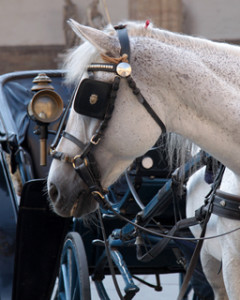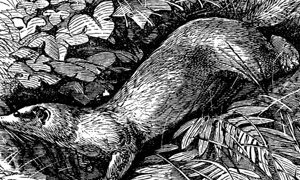Animals played an important role in life during the 19th century and accordingly they feature quite regularly within the Alienist books. Included here is some basic information on the role certain animals played within the books and the late 19th century.
Animals in the Alienist Books
Horses
Perhaps the most important animal species prior to the 20th century was the horse. They were highly valued animals due to their use in transportation, farming (e.g., pulling ploughs), and sports such as racing, hunting, and driving; other horse sports such as dressage and show jumping were rare prior to 1900.1 Within the Alienist books, two carriage horses are featured due to their owner, Dr Kreizler, requiring their use frequently. They include Frederick, a black gelding, and Gwendolyn, a brown mare. Their breed is unknown although most private carriage horses were warm or hot blooded breeds, such as the Thoroughbred. Such breeds were popular due to their speed, light frame, and elegance.1 Within The Angel of Darkness we also meet a Morgan stallion that Sara Howard hires out for use within the investigation. It is clear that all of these horses are cared for with kindness and compassion but unfortunately, such treatment was not universal.
Cruel practices with carriage and cab horses, such as extreme tightening of the bearing rein, overwork, and general maltreatment, were common place during this time period. Such practices caused these horses to break down at young ages due to resulting spine and back injuries.2 In fact, the treatment of horses was so poor for much of the 19th century that Anna Sewell was prompted to write Black Beauty. Originally, it was not promoted as a children’s book as we know it today, but rather as propaganda for humane treatment of horses.3 Additionally, such treatment of horses also prompted Henry Bergh to found the American Society for the Prevention of Cruelty to Animals in 1866, New York.4
Cats, Dogs, & Ferrets
Cats and dogs do not feature within the Alienist books as much as horses, however it was felt that it was important to include information on these animals due to their popularity as pets within the 19th century. By the mid-1800s, cats had become fashionable to keep as indoor pets. Exotic breeds with long tails and long fur were particularly prized.5 During this time period, the systematic development of new cat breeds was also occurring and the first cat shows were being held. In fact, by the 1890s, cats were so prized in some circles that at the 2nd Annual Cat Show held in Madison Square Garden, an American Shorthair was valued at $2,500 (equivalent to approximately $40,000 today).6
Dogs have been popular sporting companions to gentlemen for centuries and it was pride in their animals that prompted such a group of men to hold the first dog show in Manhattan in 1877. They decided to name the show’s associated kennel club after their favourite hotel, and it was consequently called the Westminster Kennel Club.7 The first show drew an entry of 1,201 dogs and, like the formerly mentioned cat show, some were placed up for sale for enormous amounts ranging between $50 and $10,000 (approximately $160,000 today). Dogs owned by famous individuals were also entered over the following years, including the Czar of Russia’s Siberian Wolfhound in 1889, J.P. Morgan’s Collies in 1893, and Nelly Bly’s Maltese Terrier in 1894.8
At the same time as dogs and cats were being bred as companions for the wealthy, there were an even greater number stray on the streets of Manhattan. Sadly, most of these animals were starving and many of the dogs were used in cruel practices such as dog fighting. It would take the American Society for the Prevention of Cruelty to Animals in the late 19th century to reduce this number and give both cats and dogs on the street a better life.4
The one small animal that plays a role in the Alienist books is a ferret called Mike who Stevie Taggert borrows from “Hickie the Hun” in The Angel of Darkness. As seems to be the norm in the Kreizler house, Mike is treated with the utmost kindness during his stay, including being fed with the finest steak in the house; Dr. Kreizler even orders Mike a piece of steak from Delmonico’s on one occasion. Due to the obscurity of ferrets, it is unclear whether these animals were kept as pets in New York City itself. In other parts of the world, however, they were highly prized animals due to their ability to control rabbit and rodent populations.9
American Society for the Prevention of Cruelty to Animals
During the mid-1800s, Henry Bergh fought for humane treatment of animals, who he called “these mute servants of mankind”, and founded the American Society for the Prevention of Cruelty to Animals within New York City. On April 19, 1866 an anti-cruelty law was passed and the ASPCA was given the power to enforce the law. Prison sentences and fines then followed any finding of animal cruelty within Manhattan. The following year, the first ambulance for horses began operating and later, fountains of fresh drinking water were set up for stray dogs, cats, and streetcar horses. Other duties of the ASPCA included the prevention of dog fighting, collar and saddle inspections, and educating children and adults about humane animal treatment.4
During this same period, dog catchers that were not part of the ASPCA were also in employment. These individuals often caught up to 300 dogs per day and, instead of placing them in a pound, drowned them in the river. Fortunately, by 1894 the ASPCA was placed in charge of animal control duties and such practices ceased, with animal shelters being created throughout New York City. Approximately ten years later the society opened the first animal hospital. Over the following years, the ASPCA extended to other parts of America and also prompted the start of similar societies in other countries, changing the treatment of animals worldwide for the better.4
References
1. Edwards, Elwyn Hartley. The Ultimate Horse Book. New York: Dorling Kindersley, Inc., 1991.
2. Wikipedia, “Bearing Rein” 24 Jan. 2008. Link.
3. Hastings, Waller, “Anna Sewell (1820-1878)” 30 Apr. 2004. Link.
4. Dracker, Pune, “About Us: History”, ASPCA Animal Watch Spring 1996. Link.
5. Warner, Peter. Perfect Cats. Great Britain: Sidgwick & Jackson Limited, 1991.
6. Barrett, Erin and Jack Mingo. Cats Don’t Always Land on Their Feet: Hundreds of Fascinating Facts from the Cat World. California: Conari Press, 2002.
7. Westminster Kennel Club, “Club History” 2008. Link.
8. Westminster Kennel Club, “Historical Highlights” 2008. Link.
9. Brown, Susan A., “History of the Ferret”, Off the Paw Mar./Apr. 2001. Link.


